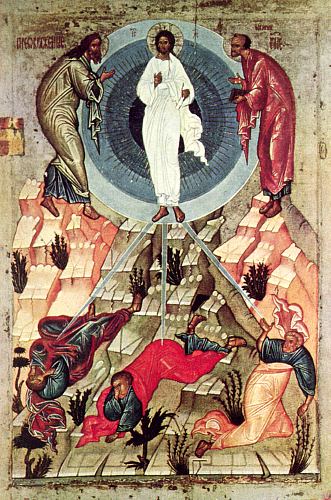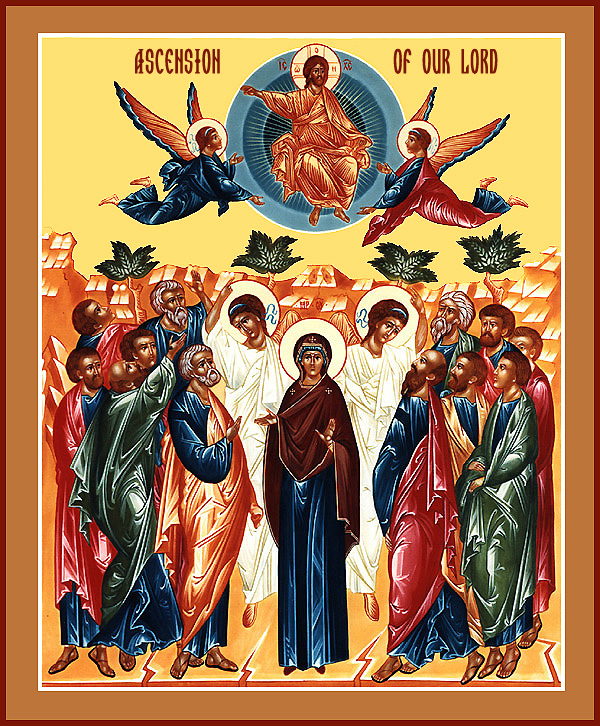I was wondering if someone could point out all the symbolism in this icon. I think the top right hand corner with the concentric circles shows the essence and energies of God but I'm not sure. Thanks guys.

You are using an out of date browser. It may not display this or other websites correctly.
You should upgrade or use an alternative browser.
You should upgrade or use an alternative browser.
St. George icon symbolism
- Thread starter Barky
- Start date
- Status
- Not open for further replies.
Kristos
Servant
I'm not expert, but it looks like it's meant to be the hand of God blessing him. Perhaps the three beams represent the Trinity. The hand is coming out of the darkness with beams of light, seems to remind me of God as darkness, but yet the light of the world. The dragon seems to represent the devil or evil in general. The white horse seems to represent purity or God's grace. He's dressed as a Roman soldier because he was. His spear is actually a cross - fitting weapon for slaying the devil.
Upvote
0
I think you may be right. The two circles in the top right hand corner are of great interest to me. Iconographers unite!
Upvote
0
ikonographics
In patience I waited patiently on the Lord
- Apr 27, 2008
- 2,530
- 497
- Country
- Greece
- Faith
- Eastern Orthodox
- Marital Status
- Single
The circles symbolise God's Divine Energy, His Grace, his presence, but never His Essence, which is completely incomprehensible to man. It is through God's Energies/Grace that we know and experience God. It is always depicted in this manner, often as a circle/oval shape surrounding Christ as in the icons of the Transfiguration

and the Ascension

Hope that helps!

and the Ascension
Hope that helps!
Upvote
0
thanks so much.
I suppose that since the "blessing hand" was coming from the outer circle and the inner circle was blank I made the distinction
I suppose that since the "blessing hand" was coming from the outer circle and the inner circle was blank I made the distinction
Upvote
0
Michael G
Abe Frohmann
- Feb 22, 2004
- 33,441
- 11,984
- 50
- Faith
- Eastern Orthodox
- Marital Status
- Married
- Politics
- US-Republican
It is greatly minimalized in this icon, but to the left of the horses leg there is a cave. In this icon the cave represents hell. Black in icons almost always represents death. The dragon is representative of the devil and sin. This icon is purely metaphorical because St. George was a young man when he died and it was never recorded him killing the dragon. But his life and witness to the faith were spiritual warfare against Satan and thus the icon is warranted.
Upvote
0
It is greatly minimalized in this icon, but to the left of the horses leg there is a cave. In this icon the cave represents hell. Black in icons almost always represents death. The dragon is representative of the devil and sin. This icon is purely metaphorical because St. George was a young man when he died and it was never recorded him killing the dragon. But his life and witness to the faith were spiritual warfare against Satan and thus the icon is warranted.
Thanks for that explanation Michael. I remember being curious about this icon the first time I saw it, but my Priest at the time was only generally knowledgeable about iconography and I had forgotten about it since.
Upvote
0
Tzaousios
Αυγουστινιανικός Χριστιανός
- Dec 4, 2008
- 8,504
- 609
- Faith
- Christian
- Marital Status
- Married
I was wondering if someone could point out all the symbolism in this icon. I think the top right hand corner with the concentric circles shows the essence and energies of God but I'm not sure. Thanks guys.
He's dressed as a Roman soldier because he was. His spear is actually a cross - fitting weapon for slaying the devil.
Everyone has provided excellent answers as to the theological symbolism in the icon. All I can add is something about the depiction of St. George as a Roman soldier.
I am not sure in what century the icon was painted. Since the depictions were almost always highly stylized and classicized, it could be from anywhere between the thirteenth to the eighteenth centuries, if I had to guess.
Because of the artistic convention, St. George and other military saints (such as the Theodores) always appear frozen in time in terms of their armament and equipment. Here the saint has on a leather klibanion (lamellar cuirass) on his upper body and leather pteryges protruding from the shoulders and around his waist.
On his lower legs are the weather resistant wrappings worn on the march. We see Byzantine soldiers and military saints depicted in much the same manner from the tenth century to the fifteenth. Whether these depict functional pieces of armor is difficult to tell; some Byzantine icons afford interesting clues in certain cases.
Upvote
0
Michael G
Abe Frohmann
- Feb 22, 2004
- 33,441
- 11,984
- 50
- Faith
- Eastern Orthodox
- Marital Status
- Married
- Politics
- US-Republican
I might add that while she is not present in this particular copy of the icon, in many copies of the icon to the right of St. George there is a woman standing next to a castle. The woman is the Empress Alexandra who secretly was a Christian and upon seeing St. George's witness followed him into martyrdom.
No, I did not write this icon.

No, I did not write this icon.

Upvote
0
- Status
- Not open for further replies.
Similar threads
- Replies
- 0
- Views
- 160
- Replies
- 1
- Views
- 131
- Replies
- 0
- Views
- 64
- Replies
- 0
- Views
- 96
